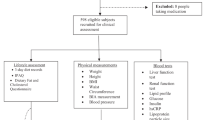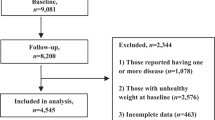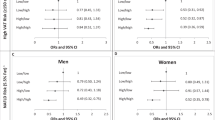Abstract
Background/Objectives
This study examined the long-term relation of lipid-soluble micronutrients with diet quality as assessed by four a priori-defined dietary patterns.
Subjects/Methods
In a prospective design, nutritional biomarkers (carotenoids, tocopherols, retinol, and coenzyme Q10) were measured using a validated HPLC-based assay. General linear models were applied to obtain covariate-adjusted means of biomarkers for tertiles of four a priori diet quality indices: Healthy Eating Index (HEI) 2010, Alternative HEI (AHEI) 2010, Alternate Mediterranean Diet Score (aMED), and Dietary Approaches to Stop Hypertension (DASH). For a subcohort of 8367 participants within the Multiethnic Cohort (MEC), diet was assessed by a validated quantitative food frequency questionnaire in 1993–96 and serum was collected in 2001–06.
Results
Participants with the highest diet-quality scores had significantly higher serum concentrations of all carotenoids, total tocopherols, and α-tocopherol, whereas γ-tocopherol was inversely associated with diet quality. Adjusted means for the lowest vs. highest tertile of HEI 2010 were 1.2 vs. 1.5 mg/L for total carotenoids, 11.4 vs. 12.3 mg/L for total tocopherols, and 1.9 vs. 1.6 mg/L for γ-tocopherol (ptrend < 0.0001). The associations for the other dietary indices were similar; no indication for sex and ethnic differences was detected. Vegetable and fruit components were major predictors of most circulating micronutrients, but most other components were also associated.
Conclusions
Higher diet-quality scores measured by four a priori diet quality indices were significantly associated higher serum concentrations of carotenoids and α-tocopherol, whereas γ-tocopherol was inversely associated with diet quality.
This is a preview of subscription content, access via your institution
Access options
Subscribe to this journal
Receive 12 print issues and online access
$259.00 per year
only $21.58 per issue
Buy this article
- Purchase on Springer Link
- Instant access to full article PDF
Prices may be subject to local taxes which are calculated during checkout


Similar content being viewed by others
References
Cespedes EM, Hu FB. Dietary patterns: from nutritional epidemiologic analysis to national guidelines. Am J Clin Nutr. 2015;101:899–900. https://doi.org/10.3945/ajcn.115.110213
Jacobs S, Harmon BE, Boushey CJ, Morimoto Y, Wilkens LR, Le Marchand L, et al. A priori-defined diet quality indexes and risk of type 2 diabetes: the Multiethnic Cohort. Diabetologia. 2015;58:98–112. https://doi.org/10.1007/s00125-014-3404-8.
Chiuve SE, Fung TT, Rimm EB, Hu FB, McCullough ML, Wang M, et al. Alternative dietary indices both strongly predict risk of chronic disease. J Nutr. 2012;142:1009–18. https://doi.org/10.3945/jn.111.157222.
Reedy J, Krebs-Smith SM, Miller PE, Liese AD, Kahle LL, Park Y, et al. Higher diet quality is associated with decreased risk of all-cause, cardiovascular disease, and cancer mortality among older adults. J Nutr. 2014;144:881-9. https://doi.org/10.3945/jn.113.189407.
George SM, Ballard-Barbash R, Manson JE, Reedy J, Shikany JM, Subar AF, et al. Comparing indices of diet quality with chronic disease mortality risk in postmenopausal women in the Women’s Health Initiative Observational Study. Evidence to inform national dietary guidance. Am J Epidemiol. 2014;180:616–25. https://doi.org/10.1093/aje/kwu173.
Harmon BE, Boushey CJ, Shvetsov YB, Ettienne R, Reedy J, Wilkens LR, et al. Associations of key diet-quality indexes with mortality in the Multiethnic Cohort: the Dietary Patterns Methods Project. Am J Clin Nutr. 2015;101:587–97. https://doi.org/10.3945/ajcn.114.090688.
World Health Organization. The global burden of chronic diseases. http://www.who.int/nutrition/topics/2_background/en/.
Bingham SA. Biomarkers in nutritional epidemiology. Public Health Nutr. 2002;5:821–7.
Jacobs S, Boushey CJ, Franke AA, Shvetsov YB, Monroe KR, Haiman CA, et al. A priori-defined diet quality indices, biomarkers and risk for type 2 diabetes in five ethnic groups. The Multiethnic Cohort. Br J Nutr. 2017;118:312–20 https://doi.org/10.1017/S0007114517002033.
Jenab M, Slimani N, Bictash M, Ferrari P, Bingham SA. Biomarkers in nutritional epidemiology: applications, needs and new horizons. Hum Genet. 2009;125:507–25 https://doi.org/10.1007/s00439-009-0662-5.
Rao AV, Rao LG. Carotenoids and human health. Pharmacol Res. 2007;55:207–16 https://doi.org/10.1016/j.phrs.2007.01.012.
Azzini E, Polito A, Fumagalli A, Intorre F, Venneria E, Durazzo A, et al. Mediterranean Diet Effect: an Italian picture. Nutr J. 2011; https://doi.org/10.1186/1475-2891-10-125.
Bach-Faig A, Geleva D, Carrasco JL, Ribas-Barba L, Serra-Majem L. Evaluating associations between Mediterranean diet adherence indexes and biomarkers of diet and disease. Public Health Nutr. 2006;9:1110–7 https://doi.org/10.1017/S1368980007668499.
Markussen MS, Veierød MB, Sakhi AK, Ellingjord-Dale M, Blomhoff R, Ursin G, et al. Evaluation of dietary patterns among Norwegian postmenopausal women using plasma carotenoids as biomarkers. Br J Nutr. 2015;113:672–82 https://doi.org/10.1017/S0007114514004103.
Kolonel LN, Henderson BE, Hankin JH, Nomura AM, Wilkens LR, Pike MC, et al. A multiethnic cohort in Hawaii and Los Angeles. Baseline characteristics. Am J Epidemiol. 2000;151:346–57.
US Department of Health and Human Services and others. US Department of Agriculture. Dietary guidelines for Americans, 2010. 7th Edition, Washington DC: US Department of Health and Human Services, December 2010.
Fung TT, McCullough ML, Newby PK, Manson JE, Meigs JB, Rifai N, et al. Diet-quality scores and plasma concentrations of markers of inflammation and endothelial dysfunction. Am J Clin Nutr. 2005;82:163–73.
Trichopoulou A, Kouris-Blazos A, Wahlqvist ML, Gnardellis C, Lagiou P, Polychronopoulos E, et al. Diet and overall survival in elderly people. BMJ. 1995;311:1457–60.
Fung TT, Chiuve SE, McCullough ML, Rexrode KM, Logroscino G, Hu FB. Adherence to a DASH-style diet and risk of coronary heart disease and stroke in women. Arch Intern Med. 2008;168:713–20 https://doi.org/10.1001/archinte.168.7.713.
Franke AA, Morrison CM, Custer LJ, Li X, Lai JF. Simultaneous analysis of circulating 25-hydroxy-vitamin D3, 25-hydroxy-vitamin D2, retinol, tocopherols, carotenoids, and oxidized and reduced coenzyme Q10 by high performance liquid chromatography with photo diode-array detection using C18 and C30 columns alone or in combination. J Chromatogr A. 2013;1301:1–9 https://doi.org/10.1016/j.chroma.2013.05.027.
Gerber M. Qualitative methods to evaluate Mediterranean diet in adults. Public Health Nutr. 2006;9:147–51.
Lipsky LM, Cheon K, Nansel TR, Albert PS. Candidate measures of whole plant food intake are related to biomarkers of nutrition and health in the US population (NHANES 1999–2002). Nutr Res. 2012;115:433–39 https://doi.org/10.1016/j.nutres.2012.03.005.
Hann CS, Rock CL, King I, Drewnowski A. Validation of the Healthy Eating Index with use of plasma biomarkers in a clinical sample of women. Am J Clin Nutr. 2001;74:479–86.
Weinstein SJ, Vogt TM, Gerrior SA. Healthy Eating Index scores are associated with blood nutrient concentrations in the third National Health And Nutrition Examination Survey. J Am Diet Assoc. 2004;104:576–84 https://doi.org/10.1016/j.jada.2004.01.005.
Kant AK, Graubard BI. A comparison of three dietary pattern indexes for predicting biomarkers of diet and disease. J Am Coll Nutr. 2005;24:294–303.
Miller ER, Erlinger TP, Sacks FM, Svetkey LP, Charleston J, Lin P-H, et al. A dietary pattern that lowers oxidative stress increases antibodies to oxidized LDL. Results from a randomized controlled feeding study. Atherosclerosis. 2005;183:175–82 https://doi.org/10.1016/j.atherosclerosis.2005.04.001.
Maiani G, Castón MJP, Catasta G, Toti E, Cambrodón IG, Bysted A, et al. Carotenoids: actual knowledge on food sources, intakes, stability and bioavailability and their protective role in humans. Mol Nutr Food Res. 2009;53:S194–218 https://doi.org/10.1002/mnfr.200800053.
Guenther PM, Reedy J, Krebs-Smith SM. Development of the Healthy Eating Index-2005. J Am Diet Assoc. 2008;108:1896–901 https://doi.org/10.1016/j.jada.2008.08.016.
Institute of Medicine (US) Panel on Micronutrients. Dietary reference intakes for vitamin A, vitamin K, arsenic, boron, chromium, copper, iodine, iron, manganese, molybdenum, nickel, silicon, vanadium, and zinc. A report of the Panel on Micronutrients. Washington DC: National Academic Press, 2001.
Guertin KA, Moore SC, Sampson JN, Huang W-Y, Xiao Q, Stolzenberg-Solomon RZ, et al. Metabolomics in nutritional epidemiology: identifying metabolites associated with diet and quantifying their potential to uncover diet-disease relations in populations. Am J Clin Nutr. 2014;100:208–17 https://doi.org/10.3945/ajcn.113.078758.
Talegawkar SA, Johnson EJ, Carithers T, Taylor HA, Bogle ML, Tucker KL. Total α-tocopherol intakes are associated with serum α-tocopherol concentrations in African American adults. J Nutr. 2007;137:2297–303.
Playdon MC, Moore SC, Derkach A, Reedy J, Subar AF, Sampson JN, et al. Identifying biomarkers of dietary patterns by using metabolomics. Am J Clin Nutr. 2017;105:450–65 https://doi.org/10.3945/ajcn.116.144501.
Cooney RV, Franke AA, Wilkens LR, Gill J, Kolonel LN. Elevated plasma gamma-tocopherol and decreased alpha-tocopherol in men are associated with inflammatory markers and decreased plasma 25-OH vitamin D. Nutr Cancer. 2008;60:21–9 https://doi.org/10.1080/01635580802404162.
Jiang Q, Christen S, Shigenaga MK, Ames BN. γ-Tocopherol, the major form of vitamin E in the US diet, deserves more attention. Am J Clin Nutr. 2001;74:714–22.
Wolf G. How an increased intake of alpha-tocopherol can suppress the bioavailability of gamma-tocopherol. Nutr Rev. 2006;64:295–9.
Bruno RS, Traber MG. Cigarette smoke alters human vitamin E requirements. J Nutr. 2005;135:671–4 https://doi.org/10.1093/jn/135.4.671.
Patel CJ, Bhattacharya J, Butte AJ. An environment-wide association study (EWAS) on type 2 diabetes mellitus. PLoS ONE. 2010;5:e10746 https://doi.org/10.1371/journal.pone.0010746.
Wajda R, Zirkel J, Schaffer T. Increase of bioavailability of coenzyme Q(10) and vitamin E. J Med Food. 2007;10:731–4 https://doi.org/10.1089/jmf.2006.254.
Bhagavan HN, Chopra RK. Coenzyme Q10: absorption, tissue uptake, metabolism and pharmacokinetics. Free Radic Res. 2006;40:445–53 https://doi.org/10.1080/10715760600617843.
Higdon J, Drake VJ, Delage B, Johnson EJ, Mayer J. Carotenoids. α-Carotene, β-carotene, β-cryptoxanthin, lycopene, lutein, and zeaxanthin. http://lpi.oregonstate.edu/mic/dietary-factors/phytochemicals/carotenoids [cited 21 Jun 2017].
Hendrickson SJ, Willett WC, Rosner BA, Eliassen AH. Food predictors of plasma carotenoids. Nutrients. 2013. https://doi.org/10.3390/nu5104051
Jonnalagadda SS, Harnack L, Liu RH, McKeown N, Seal C, Liu S, et al. Putting the whole grain puzzle together: health benefits associated with whole grains--summary of American Society for Nutrition 2010 Satellite Symposium. J Nutr. 2011. https://doi.org/10.3945/jn.110.132944
Bolling BW, McKay DL, Blumberg JB. The phytochemical composition and antioxidant actions of tree nuts. Asia Pac J Clin Nutr. 2010;19:117–23.
Maskarinec G, Lim U, Jacobs S, Monroe KR, Ernst T, Buchthal SD, et al. Diet quality in midadulthood predicts visceral adiposity and liver fatness in older ages. The Multiethnic Cohort Study. Obesity (Silver Spring). 2017;25:1442–50 https://doi.org/10.1002/oby.21868.
Acknowledgements
The Multiethnic Cohort has been supported by NCI grants R37 CA54281 (PI: LNK), U01 CA164973 (PI: LLM/CAH/LRW), and P30 CA71789 (PI: R. Holcombe). NA was supported by a student fellowship from the German Research Foundation (PROMOS) and from the Susanne Marie Sophie Haufen Foundation. None of the funders had a role in the design, analysis, or writing of this article
Author contributions:
LNK, LLM, and LRW led the design and implementation of the prospective cohort. CJB provided nutritional support and developed the diet scores. AF provided analytical services for micronutrient quantitation. NA and GM analyzed the data and wrote the paper. NA, CJB, AF, RVC, CAH, LRW, LNK, KRM, and GM contributed to the interpretation of the data, the critical revision of the article for important intellectual content, and the final approval of the version to be published. NA had primary responsibility for final content.
Author information
Authors and Affiliations
Corresponding author
Ethics declarations
Conflict of interest
The authors declare that they have no conflict of interest.
Electronic supplementary material
Rights and permissions
About this article
Cite this article
Aumueller, N., Boushey, C.J., Franke, A.A. et al. Diet quality measured by four a priori-defined diet quality indices is associated with lipid-soluble micronutrients in the Multiethnic Cohort Study (MEC). Eur J Clin Nutr 73, 703–713 (2019). https://doi.org/10.1038/s41430-018-0272-1
Received:
Revised:
Accepted:
Published:
Issue Date:
DOI: https://doi.org/10.1038/s41430-018-0272-1
This article is cited by
-
Differences in the association of diet quality with body fat distribution between men and women
European Journal of Clinical Nutrition (2020)



